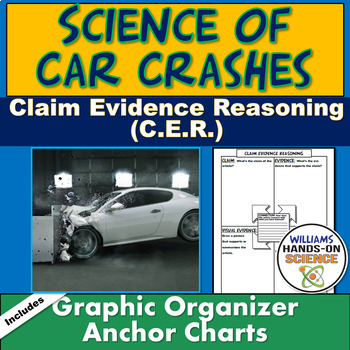NGSS Claim Evidence Reasoning Physics Car Crashes Digital
- Google Drive™ folder
- Internet Activities

Description
With this product students will learn about some of the science behind car crashes by reading an article from abcscience.com. The article asks if double a car’s speed double the force of impact. What the article explains using the equation for Kinetic Energy (KE=1/2mass x velocity²), is that impact force actually increases by 4-6 times when velocity doubles! Students will use evidence in the article that the author provides, draw visual evidence and reason why the data supports the author’s claim. Use it in Google Classroom as distance learning or in your classroom.
Claim Evidence Reasoning or C.E.R. charts are great for getting your students to explain phenomena in a meaningful way and it allows you as the instructor to adequately assess their understanding of concepts. The students figure out what the "Claim" is in the article, they then use data that supports the claim in the "Evidence" section, draw visual evidence and then explain why the evidence supports the claim in the "Reasoning " section.
You get a CER graphic organizer, anchor charts, the key, the article and the link to the website. This can be used for a current event, homework, sub plan, English Language Arts and Physics .
The article has the following concepts:
DCI's
PS2.A: Forces and Motion
For any pair of interacting objects, the force exerted by the first object on the second object is equal in strength to the force that the second object exerts on the first, but in the opposite direction (Newton’s third law). (MS-PS2-1)
The motion of an object is determined by the sum of the forces acting on it; if the total force on the object is not zero, its motion will change. The greater the mass of the object, the greater the force needed to achieve the same change in motion. For any given object, a larger force causes a larger change in motion. (MS-PS2-2)
PS3.C: Relationship Between Energy and Forces
When two objects interact, each one exerts a force on the other that can cause energy to be transferred to or from the object. (MS-PS3-2)
SEP's
Engaging in Argument from Evidence
CCC's
Systems and System Models
Cause and Effect
This is great for a current event, sub plan, distance learning, Google Classroom, homework, critical thinking, scaffolding and/or reinforcement of weather concepts!
You get a CER graphic organizer, the key, the article, tips for CER and the link to the website which is at the beginning of the article.
Thank you for taking a look!
Please follow me on TpT for new products and check me out on Instagram for my products in action!
https://www.instagram.com/williamshandsonscience/
Related Products
⭐ 10 Editable Motion Bell Ringer Warm Ups and Key
⭐ Bell Ringer Warm Up: Force, Acceleration, Graphing & Energy
⭐ Bell Ringer Warm Up: Speed, Acceleration & Graphing
⭐ Bell Ringer Warm Up: Speed, Acceleration & Graphing
⭐ Bell Ringer Warm Up: Speed, Acceleration & Graphing
⭐ Bill Nye Motion Questions and Key
⭐ Energy Warm Up
⭐ FORCES: 50 Editable PowerPoint Slides with Hyperlinks
⭐ Forces Warm Up
⭐ Frayer Models for Forces in 50+ Slide PowerPoint
⭐ MS-PS2-1 & MS-PS2-2: STEM 5E NGSS Balloon Cars Lab Engineering
⭐ MS-PS2-1: Balloon Rockets Lab
⭐ MS-PS2-1: STEM Bottle Rockets PowerPoint Graphic Organizer Close Reading & Notes
⭐ MS-PS2-2 Bell Ringer Warm Up: Distance Vs Time Graphing
⭐ MS-PS2-2: 5E NGSS Collision Lab Motion Forces Close Reading & Notes CER Article
⭐ MS-PS2-2: Newton's 2nd Law Math Problems w/Math Triangle
⭐ MS-PS2-2: PhET Simulation: Moving Man Graphing Motion Online Lab
⭐ MS-PS2-2: STEM Roller Coaster Lab & Card Sort Engineering Design Process
⭐ MS-PS3-5: NGSS Kinetic Potential Energy Card Sort Energy Worksheet Close Reading
⭐ Middle School Physics Bell Ringers (Warm Ups)
⭐ Middle School Physics Motion PowerPoint, Guided Notes, Study Guide & Test
⭐ NGSS MS-PS2-1 MS-PS2-2 Newtons Laws Science Doodles PowerPoint Notes
⭐ NGSS MS-PS2-2: STEM 5E Paper Airplane Competition Forces Interactions
⭐ NGSS MS-PS2-4 MS-PS2-2 Graphing Motion Card Sort & Graphing Questions
⭐ NGSS Newton's Laws Card Sort & 50 Slide PowerPoint
⭐ NGSS PS2.A Motion: Speed Velocity Acceleration Card Sort
⭐ NGSS PS2.A: Forces and Motion Graphing Acceleration vs Force Cause & Effect
⭐ NGSS PS2.A: Forces and Motion Graphing Acceleration vs Mass Cause & Effect
⭐ NGSS PS2.A: Forces and Motion Graphing Kinetic Energy & Speed
⭐ NGSS PS2.A: Forces and Motion Netwon's Laws Doodle Test: Christmas
⭐ NGSS Physics Speed, Time and Distance Math Problems
⭐ NGSS Speed, Time, Distance, Acceleration and Graphing Worksheets
⭐ Newton's Laws Test and Study Guide (Editable)
⭐ PS2.A PS2.B NGSS Forces and Interactions Doodle Test Assessment
⭐ Physics Online Computer Simulation Lab
⭐ Roller Coaster Energy Warm Up





